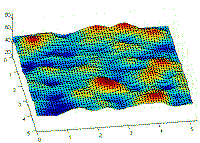Berkeley - Despite recent breakthroughs involving the use
of light to treat and study disease, those techniques only
scratch the surface of what is possible in the emerging field
of biophotonics.
A new research effort aims to change all that. Scientists
at 10 institutions around the country, including the University
of California, Berkeley, announced today (Thursday, Oct.
24) a new Center for Biophotonics Science and Technology
to accelerate the application of state-of-the-art optical
tools to biology and medicine.
The National Science Foundation (NSF) is providing $40
million over 10 years to establish the center at UC Davis,
in collaboration with researchers from UC Berkeley, Lawrence
Livermore National Laboratory (LLNL), UC San Francisco,
Stanford University and other universities. An additional
$12 million in matching funds from federal and state grants
and private sources will bring total funding for the center
to about $52 million.
"Biophotonics refers to the application of advanced optical
technology to study biological processes," said Jay T. Groves,
an assistant professor of chemistry at UC Berkeley, a faculty
scientist at Lawrence Berkeley National Laboratory (LBNL)
and one of the principal investigators with the center.
"Light is an extremely powerful way of probing and manipulating
things to find out what they do. The full potential of optical
technology in biomedical applications is still largely untapped."
Lasers, for example, are widely used today in medicine
and surgery, and the center hopes to spur the development
of new applications
"Lasers are indispensable in a number of surgical specialties,
from dermatology to oncology, and the development of new
medical laser technologies and techniques offers tremendous
opportunities to improve the practice of medicine further,
from developing better sutures to treating osteoporosis,"
said James E. Boggan, professor of neurological surgery
at the UC Davis School of Medicine and Medical Center and
co-director of the center.
Researchers at the new center hope also to develop new
technologies for detecting anthrax and other biological
weapons, and new tools to diagnose and treat cancer. Another
goal is to develop new technology that will enable scientists
and physicians to see what takes place in living cells and
how the different components function in real time.
"Through the power of biophotonics and some of the new
technologies that we're developing, we will be able to see
the cell while it's living, talking and interacting with
other cells around it," said Dennis Matthews, director of
the new center and an expert on lasers and optics at LBNL.
Groves himself uses sophisticated optically coupled atomic
force microscopes to manipulate individual cell membranes
only two molecules thick, laser trapping to isolate and
study proteins, and optical standing wave interferometry
to record real-time movement of proteins in cell membranes.
"There is much more to light than an image," said Groves,
who is part of UC Berkeley's Health Sciences Initiative,
a broad-based collaboration among campus researchers to
tackle some of today's major health problems. "Conventional
microscopes use only a small fraction of the optical information
from our samples - there is infinitely more we can do."
| |

Thermal
fluctuations in a membrane in contact with a second
membrane, as occurs at a synapse between two cells.
The topography was measured to nanometer precision with
a technique called optical standing wave interferometry.
Blue regions indicate spots where the two membranes
are bound together and thus move the least. The real
time motion, though seemingly random, reveals patterns
in the molecules embedded in the membrane. Credit:
Jay T. Groves and Yoshihisa Kaizuka/UC Berkeley
|
Groves' main interest is how cells recognize one another
and communicate, which he thinks involves physical interactions
as well as chemical signals. Because these interactions
occur where two cell membranes touch, he has developed a
way to study the real-time interactions at the interface
between two cell membranes. Groves hopes to prove a hypothesis
he and his collaborators have proposed over the last couple
years, that physical contact between two membranes forces
proteins embedded in the surface to form a pattern that
the cell can read.
"We think that the cell reacts to the pattern it finds
on its surface, rather than only counting how many proteins
chemically bind to a ligand or receptor," he said. "As a
pattern forms, it drags things around in the surface and
probably forces a signaling cascade that influences the
whole cell."
Optical standing wave interferometry allows Grove to map
the topography of the region where two membranes touch and
see the molecules moving around, with patterns emerging
from among the thermal fluctuations. Using this "molecular
sonar," he can see detail on the scale of nanometers, a
size hundreds of times smaller than conventional optical
microscopes can resolve. He hopes eventually to see predicted
patterns forming, and to apply what he learns to signaling
among cells of the immune system.
Figuring out how cells communicate has practical applications,
Groves said. He has successfully attached membranes to silicon
chips, providing a pillow on which cells can move and grow.
One goal is to create biochips to sense disease-causing
bacteria or viruses.
"Cells are better than any human-built device in sensing
the environment, so let the cells tell us," he said. "First,
though, we have to find out how to send signals to make
the cell look for things we're interested in, and we must
learn how to capture signals from these cells."
The center's major focus will be to collaborate with industry
to accelerate biophotonics technology development and deliver
this new technology into the hands of health-care providers.
UC
Davis will be the West Coast hub for biophotonics research
that business partners can use to make new, leading edge
medical devices.
The biophotonics center was one of six science and technology
centers established this year by the NSF. The other centers
will use the money to explore areas such as space weather
and water purification systems.